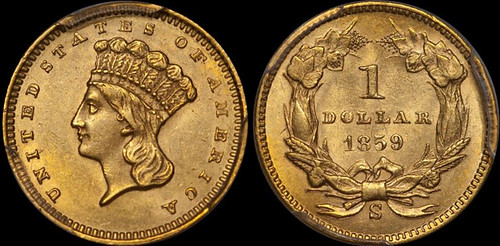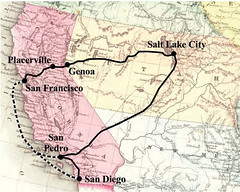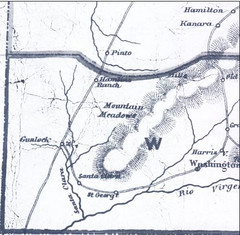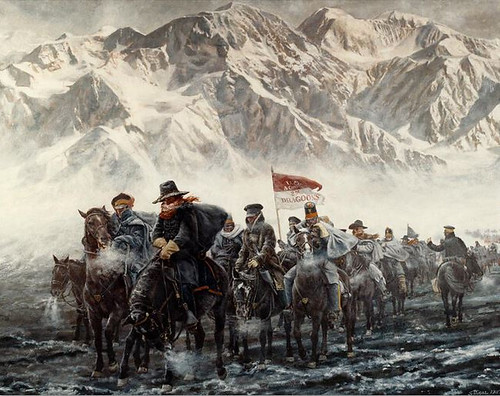
PREV ARTICLE
NEXT ARTICLE
FULL ISSUE
PREV FULL ISSUE
MAJOR PRINCE AND THE 1859-S ONE DOLLAR GOLD PIECESDan Owens submitted this original article
tracing a significant number of the surviving examples of 1859 S
gold dollars to an 1859 Utah Army payroll. Thanks! -Editor
Major Prince and the 1859 S San Francisco Branch Mint one
dollar gold pieces
 Spring had finally arrived after a hard winter, and with it a renewed sense of optimism. The hourglass that marked the seasons had finally turned and grains of gold would begin their annual march to the Branch Mint.
The San Francisco Bulletin on April 19th, stated that Prince had received the greater part of the amount of $150,000 coined in the Mint here in one dollar gold pieces. However, the Branch Mint had only struck 74,232 one dollar gold coins in total, for the years 1854-1859. Instead, I think a more accurate statement would be that he received nearly $15,000 in one dollar gold coins as part of the Army's payroll. Thus I believe that a significant number of the surviving examples of 1859 S gold dollars were a part of Prince's 1859 Utah Army payroll. The destination of the payroll was Camp Floyd located at Fairfield, Utah Territory. The newspapers wrote about the scarcity of money that had been severely felt during the winter months, not only by the Army but by the sutlers, merchants and dealers in general, who had been looking with anxiety for the return of Major Prince from California. The Deseret News took exception to the news item published in the Bulletin, stating that the local folks had been led to believe that no inconsiderable amount of the "hard stuff" would be shortly put in circulation after the return of the Paymaster. The writer went on to sarcastically comment that the golden dreams of the money seekers will not be realized to any extent this time. In addition, the amount and type of money (one dollar gold pieces) obtained by Prince could have been brought through by any private gentleman without exciting the suspicions of a fellow traveler that he had more than the necessary pocket money along with him. The writer concluded by asking if the Bulletin actually thinks that $150,000 would pay off the troops in the Department of Utah, when a number with one more zero on the right would be better suited to get the job done. Regardless, on April 20th, Prince had left San Francisco Bay on the steamer Senator bound south for the port of San Pedro. He would then travel overland by way of Los Angeles and San Bernardino to the Utah Territory. 
 On April 21st, General Johnston, in command of soldiers in the thousands at Camp Floyd, gave Captain Reuben P. Campbell 2nd Dragoons, orders to travel as far south as Santa Clara in Southern Utah with one company of Dragoons and two of infantry. His mission was to protect travelers on the southern route in the spring from possible Indian threats and to escort Prince in his quest to deliver the payroll to Camp Floyd. An eyewitness to a review of Johnson's forces at the Camp noted that the Dragoons on horseback in full dress and the batteries of Artillery, put on an unequaled display of splendor and effect.  Meanwhile, the Los Angeles press noted that on April 24th, Major Prince took out $147,000, to pay the army and attaches in Utah. Brevet Major James H. Carleton, Company K, 1st Dragoons, would command the escort, alongside him was Lieut. C.H. Ogle. The armed escort had arrived from Fort Tejon north of Los Angeles. A Los Angeles based correspondent believed that Prince was really carrying half a million dollars. On April 26th, the U.S. Army payroll was rolling through the Cajon Pass. The entourage consisted of half a dozen wagons, with mule teams; an ambulance, and a few travelers, who were well known to the soldiers. An insider wrote: "Thus far, the road, country, weather, grass, water and wood, have made our march a pleasure trip." Major Prince and his escort exchanged wagons at the Muddy (a river approximately 60 miles north of present day Las Vegas), with Major Paul who had left Provo on April 21st. It was noted that, Major Carleton, Lieut. Ogle and men were all well, and progressing comfortably. The Indians along the road were peaceable. During the month of May, Major Carleton via Prince's treasure convoy had met up with Captain Campbell's forces at the Santa Clara River in Utah before heading up to Mountain Meadows. In a detailed report published in 1859, entitled Special Report on the Mountain Meadows Massacre, Carleton stated he left Los Angeles on the 23rd of April, not the 24th alluded to earlier in the Los Angeles press, along with specific orders from General Clarke of the California Department to bury the bones of the Mountain Meadows massacre victims. In September of 1857, a wagon train of Arkansas emigrants had been massacred primarily at the hands of a band of Mormons disguised as Indians. Upon Carleton's arrival at Mountain Meadows on May 16th, Campbell came up with his men from their encampment at the Santa Clara. Both parties would now make camp at the site. On his way down from Camp Floyd, Campbell's command had already stopped at Mountain Meadows and under the skillful eyes of Assistant Surgeon Dr. Brewer United States Army, buried a number of human remains that were plainly visible and scattered about the grounds. A grim reminder of a dark page in the history of the West. On May 20th, Carleton lead a party of men and made a more thorough search for human remains particularly amongst the sage brush and had them interred in a common grave marked by a stone cairn made of loose granite with a cross on top. Both Paymaster Prince, Dr. Brewer and others would help Carleton sift through the evidence for his report. On June 1st, Prince arrived at Camp Floyd under the escort of Captain Campbell. To quote a local source: "All the gamblers, etc. have gone there, and we may soon expect to record a rush of business and plenty of the needful..." Prince, and Carleton went on to serve honorably for the Union in the Civil War. Campbell resigned from the United States Army and joined the Confederacy out of his native state of North Carolina. He died leading a charge of his men at the first battle of Cold Harbor in 1862. According to United States gold coin expert Doug Winter, the 1859 S one dollar gold piece is undervalued in Uncirculated. Winter states: There are probably around 15 or so known (which makes it comparable to the much better- known and more highly valued 1859 D) with nearly all in MS 60 to MS 61. In MS 62, the 1859 S is quite rare and he has never seen an example that graded higher than MS 63. He believes the 1859 S is one of the more undervalued issues in the entire gold dollar series. Wayne Homren, Editor The Numismatic Bibliomania Society is a non-profit organization promoting numismatic literature. See our web site at coinbooks.org. To submit items for publication in The E-Sylum, write to the Editor at this address: whomren@gmail.com To subscribe go to: https://my.binhost.com/lists/listinfo/esylum All Rights Reserved. NBS Home Page Contact the NBS webmaster 
|
